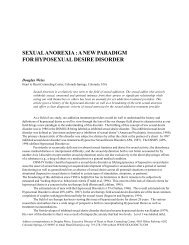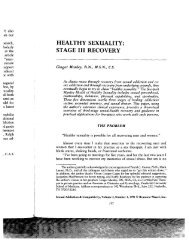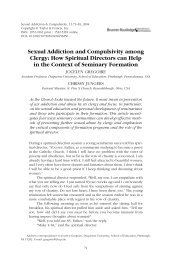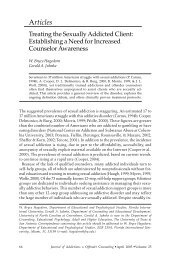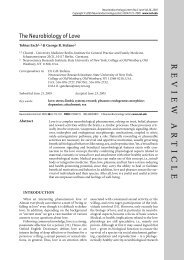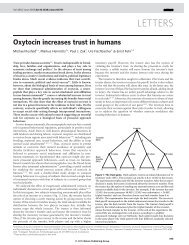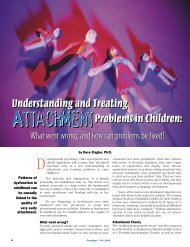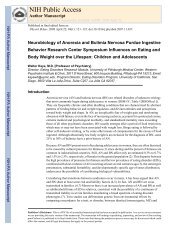recognizing and managing erotic and eroticized transferences
recognizing and managing erotic and eroticized transferences
recognizing and managing erotic and eroticized transferences
Create successful ePaper yourself
Turn your PDF publications into a flip-book with our unique Google optimized e-Paper software.
[PSYCHOTHERAPY ROUNDS]<br />
Series Editor: Paulette Marie Gillig, MD, PhD<br />
RECOGNIZING AND MANAGING EROTIC<br />
AND EROTICIZED TRANSFERENCES<br />
by DARNELL LADSON, DO; <strong>and</strong> RANDON WELTON, MD, LtCol, USAF<br />
Drs. Ladson, Welton, <strong>and</strong> Gillig are from the Department of Psychiatry, Wright State University, Dayton, Ohio.<br />
ABSTRACT<br />
Transference has been proposed<br />
as a critical concept in<br />
psychotherapy. The transference<br />
may be positive, negative, or<br />
sexualized. When the transference<br />
becomes sexualized, there are<br />
potentially damaging outcomes<br />
depending on the management of<br />
the transference. This paper<br />
addresses the significance of early<br />
experiences in residency training<br />
with sexualized transference <strong>and</strong><br />
focuses on the therapeutic<br />
relationship in which the<br />
transference has become <strong>erotic</strong>ized.<br />
The author will explore the<br />
potential benefits <strong>and</strong> challenges of<br />
properly <strong>managing</strong> such<br />
transference.<br />
INTRODUCTION<br />
Transference has been described<br />
as unconscious feelings that are<br />
transposed onto another significant<br />
individual. 1 In the strictest sense,<br />
this occurs only in therapy settings,<br />
but in a more general sense it<br />
occurs throughout life. The<br />
experience of transference might be<br />
thought of as a means used by the<br />
brain to make sense of current<br />
experience by seeing the past in the<br />
present <strong>and</strong> limiting the input of<br />
new information. 2 Freud noticed the<br />
unusually <strong>and</strong> sometimes<br />
irrationally intense feelings that<br />
developed between patients <strong>and</strong><br />
their analysts. He initially<br />
conceptualized the transference as<br />
the patient’s attempt to repress<br />
ADDRESS CORRESPONDENCE TO: Darnell Ladson, DO, Department of Psychiatry, Wright State<br />
University, 627 Edwin C. Moses Blvd., East Medical Plaza, First Floor, Dayton, OH 45408; Phone:<br />
(937) 223-8840; E-mail: darnell.ladson@wright.edu<br />
KEY WORDS: psychotherapy, countertransference, transference, sexualized transference, <strong>erotic</strong><br />
transference, <strong>erotic</strong>ized transference<br />
[APRIL] Psychiatry 2007 47
childhood experiences. Later he<br />
observed that feelings of love not<br />
only occurred in the past outside<br />
the therapy session, but also during<br />
the analysis itself toward the<br />
analyst. 3<br />
Sexualized transference is any<br />
transference in which the patient’s<br />
fantasies about the analyst contain<br />
elements that are primarily<br />
reverential, romantic, intimate,<br />
sensual, or sexual. 4 As early as<br />
1915, Freud addressed this<br />
phenomenon in his paper,<br />
“Observation on Transference<br />
Love.” 3 He described transference<br />
love as occurring when the patient<br />
openly announces love for the<br />
therapist.<br />
At the time Freud wrote about<br />
“transference love,” the field of<br />
psychoanalysis was under attack by<br />
the public. Some of these attacks<br />
centered on reports of sexual<br />
experiences between analysts <strong>and</strong><br />
their patients. Freud struggled with<br />
whether transference came from<br />
the real relationship between the<br />
patient <strong>and</strong> therapist or if it was<br />
entirely unreal (i.e., displaced<br />
feelings from other relationships).<br />
Today there are ongoing<br />
discussions in the literature about<br />
the nature <strong>and</strong> role of transference.<br />
The transference relationship is<br />
complex <strong>and</strong> multilayered while<br />
being significantly impacted by<br />
countertransferential reactions.<br />
The therapist has become less of a<br />
“blank screen” <strong>and</strong> more<br />
interactive with the patient <strong>and</strong>,<br />
therefore, a part of the developing<br />
transference. Transference may be<br />
utilized to gather psychological<br />
material <strong>and</strong> gain a deeper<br />
underst<strong>and</strong>ing of the patient’s<br />
motivations. 5 Contemporary<br />
analysts contend, as their<br />
predecessors once did, that <strong>erotic</strong><br />
transference reflects a patient’s<br />
early life impulses <strong>and</strong> fantasies<br />
that emerge during the process of<br />
analysis.<br />
TYPES OF TRANSFERENCE<br />
In general, transference may<br />
manifest itself as positive, negative,<br />
or sexualized. In positive<br />
transference, the patient<br />
experiences enjoyable aspects of<br />
past relationships. Positive<br />
<strong>transferences</strong> are often helpful in<br />
therapy if the patient sees the<br />
therapist as wise, caring, <strong>and</strong><br />
concerned.<br />
Negative transference<br />
unleashes emotions that are painful<br />
or less desired. By discussing these<br />
negative emotions with the patient,<br />
the therapist hopes to help the<br />
patient achieve insight <strong>and</strong> to find<br />
ways to manage these feelings.<br />
Positive <strong>and</strong> negative<br />
transference can become topics for<br />
discussion in therapy. The patient<br />
is encouraged to acknowledge <strong>and</strong><br />
discuss emotional responses to the<br />
therapist, especially if they seem<br />
out of proportion to what has<br />
actually transpired in the session<br />
Positive <strong>and</strong> negative transference can become<br />
topics for discussion in therapy. The patient is<br />
encouraged to acknowledge <strong>and</strong> discuss<br />
emotional responses to the therapist, especially<br />
if they seem out of proportion to what has<br />
actually transpired in the session itself.<br />
itself. This allows patients to make<br />
connections between what they are<br />
feeling in the room with their<br />
therapist <strong>and</strong> their early life<br />
experiences, <strong>and</strong> this enables<br />
development <strong>and</strong> growth.<br />
Transference situations that are<br />
not interfering with the therapeutic<br />
process are often left<br />
uninterpreted. It can be a technical<br />
challenge to address transference<br />
in therapy, because raising<br />
awareness to the transference can<br />
stress the patient, leading to<br />
regression or awkward <strong>and</strong><br />
embarrassing moments in therapy.<br />
The acknowledgment of<br />
transference feelings, if sexual, may<br />
be mistaken as an invitation for<br />
further flirtation or a sexual<br />
relationship. This could lead to the<br />
collapse of the safe environment the<br />
therapist has struggled to create. 6 It<br />
is of course unethical to use the<br />
discussion of the intense feelings<br />
involved in the transference for a<br />
therapist’s own self-gratification,<br />
<strong>and</strong> this is to be avoided.<br />
COUNTERTRANSFERENCE:<br />
BOUNDARY ISSUES FOR<br />
PSYCHOTHERAPISTS<br />
The intense emotional<br />
experience of countertransference<br />
in psychotherapy also is not rare.<br />
Some studies have reported that 95<br />
percent of male therapists <strong>and</strong> 76<br />
percent of female therapists admit<br />
that they felt sexual feelings toward<br />
their patients. 6 Identifying <strong>and</strong><br />
therapeutically <strong>managing</strong> one’s own<br />
intense feelings is one of the ongoing<br />
challenges of<br />
psychodynamically based<br />
psychotherapy. These challenges<br />
are enhanced in the novice<br />
therapist who may have little<br />
training in these issues <strong>and</strong> virtually<br />
no experience with them.<br />
PRACTICE POINT: Family of<br />
Origin Issues <strong>and</strong> Potential for<br />
Transference in the Therapeutic<br />
Relationship<br />
Case example. A middle-aged<br />
woman describes her childhood<br />
as being filled with rage. She<br />
attributes this to her emotionally<br />
abusive father <strong>and</strong> sexually<br />
abusive brother. She states that in<br />
order to enhance her sense of<br />
safety, she developed techniques<br />
to control <strong>and</strong> manipulate her<br />
father.<br />
In psychotherapy with a male<br />
therapist, a patient might display<br />
48<br />
Psychiatry 2007 [APRIL]
ehavior that is reminiscent of early<br />
childhood relationships. A female<br />
may become overtly flirtatious with<br />
her male therapist <strong>and</strong> inform her<br />
therapist that it would be more<br />
comfortable to have therapy at a<br />
local restaurant. In doing so, the<br />
patient unconsciously attempts to<br />
equalize the power differential by<br />
attempting to shift the frame under<br />
which the original therapy had been<br />
established. The therapist may view<br />
this as flattering or just a part of<br />
the patient’s overall pathology.<br />
Nonetheless, being aware of the<br />
potential pitfalls of mis<strong>managing</strong><br />
the transference may be critical to<br />
helping the patient underst<strong>and</strong><br />
current <strong>and</strong> early childhood<br />
relationships.<br />
THE CONCEPT OF<br />
TRANSFERENCE<br />
Transference is a crucial<br />
component in the therapeutic<br />
relationship <strong>and</strong> should be<br />
incorporated into psychotherapy<br />
education from the beginning.<br />
During most psychiatric<br />
residencies, although transference<br />
is discussed in a general way,<br />
discussion on the management of<br />
sexualized transference often is<br />
limited.<br />
Types of sexualized<br />
transference. The term<br />
sexualized transference is often<br />
used as the most general term <strong>and</strong><br />
encompasses at least two more<br />
specific experiences, <strong>erotic</strong> <strong>and</strong><br />
<strong>erotic</strong>ized transference.<br />
Differentiating between the two<br />
types of sexualized transference is<br />
important because the intensity, the<br />
underlying motivation, <strong>and</strong> the<br />
appropriate interventions are<br />
different.<br />
Erotic transference. The term<br />
<strong>erotic</strong> transference is generally<br />
reserved for positive <strong>transferences</strong><br />
accompanied by sexual fantasies<br />
that the patient underst<strong>and</strong>s to be<br />
unrealistic. 7 This transference does<br />
not interfere with the patient’s goal<br />
to gain insight <strong>and</strong> mature<br />
attachments.<br />
Eroticized transference.<br />
Eroticized transference is an<br />
intense, vivid, irrational <strong>erotic</strong><br />
preoccupation with the therapist<br />
characterized by overt, seemingly<br />
egosyntonic dem<strong>and</strong>s for love <strong>and</strong><br />
sexual fulfillment. 1 The patient is<br />
unable to focus on developing<br />
appropriate insights <strong>and</strong> attends<br />
the sessions for the opportunity to<br />
be close to the therapist, with the<br />
hope that the therapist will<br />
reciprocate love.<br />
PRACTICE POINT: The<br />
Therapist’s Response to<br />
Sexualized Transference<br />
Case example. After several<br />
months of therapy, the patient<br />
begins to make flirtatious<br />
comments about the therapist’s<br />
clothing <strong>and</strong> posture in the<br />
room.<br />
The therapist emphasizes, by<br />
words <strong>and</strong> actions, the boundaries<br />
of the psychotherapeutic<br />
relationship, while controlling any<br />
outward display of anxiety or<br />
discomfort. The purpose of this<br />
intervention is to create an<br />
environment where the patient<br />
feels comfortable spontaneously<br />
expressing feelings without being<br />
judged, shamed, or rejected, while<br />
still maintaining the structure <strong>and</strong><br />
limits of the relationship.<br />
In psychoanalytic terminology,<br />
Gabbard compares the relationship<br />
between the male “analyst” <strong>and</strong><br />
female “analsy<strong>and</strong>” to that of father<br />
<strong>and</strong> adolescent daughter. 8 A father<br />
must remain sensitive <strong>and</strong> close to<br />
his daughter while maintaining the<br />
boundaries between them. For<br />
many psychiatric patients, early<br />
memories are plagued by episodes<br />
of intimidation <strong>and</strong> victimization by<br />
important adults, <strong>and</strong> boundaries<br />
may need to be reaffirmed<br />
frequently to prevent<br />
misinterpretations of activities <strong>and</strong><br />
The appropriate response [by the therapist] to<br />
<strong>erotic</strong> transference often is to address the<br />
recent behavior in therapy without connecting<br />
it to early life experiences. This is because<br />
bringing behavior to conscious awareness<br />
without interpretation can help to minimize the<br />
risk of further “flirting” or other acting out.<br />
comments in therapy sessions.<br />
Sexualized transference was<br />
acknowledged initially in Freud’s<br />
early writings. Freud became aware<br />
of the phenomenon while working<br />
closely with the case of “Anna O,”<br />
but at the time he was reluctant to<br />
acknowledge such transference. It<br />
was not until several cases later<br />
that he realized the significance of<br />
this transference. He thought it<br />
was important that analysts<br />
underst<strong>and</strong> “transference love,” so<br />
that they were able to<br />
appropriately manage it.<br />
Unfortunately, sexualized<br />
transference is usually discussed in<br />
the context of a therapy case<br />
where the therapist presumably<br />
mismanaged the transference.<br />
Proper management of sexualized<br />
transference often can be<br />
therapeutic, however. The nature<br />
of transference is that it is<br />
unconscious <strong>and</strong> thus out of the<br />
patient’s awareness. A skilled<br />
therapist can assist the patient to<br />
identify <strong>and</strong> work through the<br />
issues that are involved. 9<br />
The appropriate response to<br />
<strong>erotic</strong> transference often is to<br />
address the recent behavior in<br />
therapy without connecting it to<br />
[APRIL] Psychiatry 2007 49
Making any connection between early<br />
childhood experiences <strong>and</strong> transference early<br />
in the therapeutic relationship might be<br />
inappropriate as there may not have been<br />
enough time to establish positive rapport.<br />
early life experiences. This is<br />
because bringing behavior to<br />
conscious awareness without<br />
interpretation can help to minimize<br />
the risk of further “flirting” or other<br />
acting out. When such an<br />
intervention is successful,<br />
psychotherapy becomes more<br />
beneficial. Often the patient feels<br />
less guarded <strong>and</strong> more open to<br />
gaining <strong>and</strong> utilizing insight,<br />
particularly with respect to<br />
intimate feelings <strong>and</strong> concerns<br />
about other important male figures<br />
in her life.<br />
Making any connection between<br />
early childhood experiences <strong>and</strong><br />
transference early in the<br />
therapeutic relationship might be<br />
inappropriate as there may not<br />
have been enough time to establish<br />
positive rapport. Such an<br />
interpretation may be rejected if it<br />
is prematurely offered. This is a<br />
delicate topic that requires welldeveloped<br />
rapport with the patient<br />
to limit the potential risk of the<br />
patient impulsively terminating<br />
therapy.<br />
THE IMPORTANCE OF<br />
MAINTAINING APPROPRIATE<br />
BOUNDARIES<br />
If the therapist experiences<br />
sexual feelings for a patient, the<br />
therapist may become either<br />
inappropriately involved with the<br />
patient or aloof toward the patient<br />
in an effort to maintain emotional<br />
distance. 7 Either of these responses<br />
can cause further injury to the<br />
patient. Novice therapists in<br />
particular may have trouble<br />
negotiating the boundary between<br />
distancing themselves from<br />
patients <strong>and</strong> becoming overly<br />
involved. The beginning therapist<br />
may be frightened of the patient’s<br />
intense emotions <strong>and</strong> tend to<br />
ignore or overreact to them.<br />
Although the novice may have read<br />
about sexualized transference, he<br />
or she may be tempted to deny its<br />
power when working with a patient<br />
because of lack of confidence in<br />
one’s ability to manage it or<br />
because he or she believes that<br />
others will see this identification of<br />
sexualized transference as clinically<br />
inaccurate or based on their own<br />
narcissism. 3 These issues should be<br />
carefully addressed in supervision<br />
or peer consultation if needed, so<br />
that therapy can progress while<br />
appropriate boundaries are<br />
carefully maintained <strong>and</strong> no serious<br />
boundary violations occur.<br />
REFERENCES<br />
1. Bloom H. The concept of<br />
<strong>erotic</strong>ized Transference. J Am<br />
Psychoannal Assoc<br />
1973;21:61–76.<br />
2. Kay J, Kay R. Individual<br />
psychoanalytic psychotherapy. In:<br />
Tasman A, Kay J, Lieberman J.<br />
Psychiatry, Second Edition.<br />
2003:1699–718.<br />
3. Freud S. Observations on<br />
Transference Love: Further<br />
Recommendations on the<br />
Technique of Psychoanalysis,<br />
III, St<strong>and</strong>ard Edition. London:<br />
Hogarht Press, 1915;(12).<br />
4. Book HE. The “<strong>erotic</strong><br />
transference:” Some technical<br />
<strong>and</strong> countertranferential<br />
difficulties. Am J Psychother<br />
1995;49(4):504–13<br />
5. Person E. How to work through<br />
<strong>erotic</strong> transference. Psychiatr<br />
Times 2003;20(7):29.<br />
6. Mor B. The space between love<br />
<strong>and</strong> not touching in<br />
psychotherapy. Am J Psychother<br />
2005;59(1):42–60.<br />
7. Koo MB. Erotized transference in<br />
the male patient-female therapist<br />
dyad. J Psychother Pract Res<br />
2001;10(1):28–36.<br />
8. Gabbard GO. Psychodynamic<br />
psychiatry in the “decade of the<br />
brain.” Am J Psychiatry<br />
1992;149:991–8.<br />
9. Coen S. Love between therapist<br />
<strong>and</strong> patient: A review. Am J<br />
Psychother 1996;50(1):14–27.<br />
50<br />
Psychiatry 2007 [APRIL]



